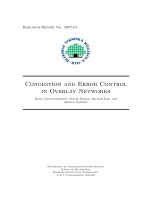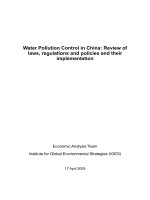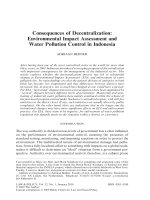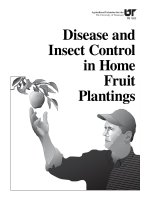disease and insect control in home fruit plantings
Bạn đang xem bản rút gọn của tài liệu. Xem và tải ngay bản đầy đủ của tài liệu tại đây (548.94 KB, 10 trang )
Disease and
Insect Control
in Home
Fruit
Plantings
Agricultural Extension Service
The University of Tennessee
PB 1622
Disease and Insect Control in Home Fruit Plantings
Steve Bost, Professor, Karen Vail, Associate Professor, and Frank Hale, Associate Professor
Entomology and Plant Pathology
Growing fruit in the home garden can be an interesting, fun
and rewarding hobby. Many novices dream of plucking perfect
fruit off trees in their yards. This does not happen without a great
deal of work. Control of pests (insects and diseases) is an
integral part of the care necessary to achieve good results.
This publication provides guidelines for spraying home fruit
plantings, but good pest control is not possible if spraying is the
only action taken. Cultural practices such as pruning, sanitation,
variety selection and selecting open, sunny sites for planting are
necessary for good pest control. Specific cultural practices for
each type of fruit are provided with the spray charts.
How to Use the Spray Schedules
Most fungicide (disease control product) and some
insecticide (insect control product) applications are effective only
if applied preventatively, because it is not possible to control the
pest satisfactorily after the fact. The timing of these preventive
sprays is based on the growth stage of the plant and forms the
foundation of the spray charts that follow.
In very rainy seasons, sprays may need to be applied more
frequently than the schedule given in the following charts. Wet
weather favors development of the disease-causing organisms;
thus, more chemical protection is needed. Also, rains can wash off
the pesticides (fungicides and insecticides). When rain occurs
before a spray has dried or if rainfall totals more than 1 inch
within 24 hours, the spray should be re-applied. Fungicides
provide more benefit when applied before a rain than after,
because protection from infection by disease-causing organisms is
needed when plant surfaces are wet.
Additional Spray Tips
Thorough coverage of all above-ground plant parts is needed
for good pest control. One of the biggest mistakes home fruit
growers make is to allow their trees to grow too tall. If trees are
maintained at a manageable height, it is easier to spray them
properly, as well as to harvest the fruit. Proper pruning practices
reduce the amount of spray needed and permit better coverage.
The type of sprayer used depends on the size of the fruit
planting. For most plantings of small fruits or for a few small fruit
trees, pump-up sprayers are adequate. Trombone-type sprayers are
helpful for taller trees. For the increased spray volumes required
by larger home orchards, power sprayers are recommended.
Rates of product application are not provided in these charts,
because of the diversity of product concentrations offered. The
product labels give the rates; follow them. The label rates are
expressed as amount per gallon of water. The following table can
be used to determine the amount of spray mixture needed.
Protect Pollinating Insects
Honey bees and other pollinating insects must be protected
from insecticides, which will kill them. Do not spray fruit plants
with insecticides while the plants are in bloom.
Amount of spray needed for each application
Height in feet
Spread in feet
Gal. per tree
er application p
5 to 8
3 to 6
2 to 1
8 to 10
4 to 8
1 to 2
10 to 15
8 to 15
3 to 5
Pesticide Safety
Most of the pesticides suggested for use in this publication
are low-toxicity materials; however, some precautions are still
needed.
C Keep pesticides in the original, labeled container.
C Keep pesticides in a locked storage cabinet, away from children
or pets.
C Read the label each time before you use the product.
C Wear rubber gloves, goggles, a long-sleeved shirt, long pants
and a hat when mixing and applying pesticides. Refer to the
label for required protective gear.
C Handle the pesticide carefully when mixing. Avoid breathing
dust or vapors. Wash any chemicals off the skin immediately
with plenty of water.
C Never apply insecticides or fungicides with a sprayer that has
been used for weed killers.
C Do not spray if it is windy.
C Mix only as much as you need. Do not store diluted spray
mixtures from one application to the next. They will lose
effectiveness and are unsafe.
C Observe the harvest intervals and reentry requirements given in
the following table and on the product label.
Multipurpose Fruit Spray
Growers with small fruit plantings may want to consider
multipurpose fruit spray products. These materials are widely
available, convenient and will serve most pest control purposes.
They are mixtures containing a fungicide (captan), and usually
two insecticides (malathion and methoxychlor). Multipurpose
sprays are produced by several companies and sold under names
such as Home Orchard Spray
7
, Tree Fruit Spray
7
, All Purpose
Fruit Spray
7
, General Purpose Fruit Spray
7
and others. Certain
brands contain an additional insecticide, carbaryl (Sevin).
Mixtures containing carbaryl should not be applied to apple or
pear until 21 days after petal fall, as it causes the fruit to drop.
It appears that no products, including mixtures, are currently
registered in Tennessee with residential uses of methoxychlor or
phosmet. We have left these insecticides in this publication
because currently you can use existing stock.
3
Harvest Restrictions
The following tables contain the most readily available home fruit pesticides, the crops on which they can be used and the harvest
restrictions. If any information in the tables disagrees with the product label, FOLLOW THE INFORMATION ON THE LABEL.
Harvest Restrictions for Common Fruit Fungicides
Waiting period in days between final spray and harvest
Common
Names
Example Brand
Names
a
Apple
Pear
Peach
Cherry
Plum
Blackberry
Raspberry
Straw-
berry
Grape
Blueberry
captan
Captan, Rescue,
Orthocide
0
0
0
0
0
nr
0
0
0
chlorothalonil
Daconil, Fungi-
Shield, Fungi-Gard
nr
nr
*
*
*
nr
nr
nr
nr
copper
Bordeaux Mix,
Copper Fungicide
0
0
0
0
0
0
0
0
0
ferbam
Carbamate, Ferbam
7
7
21
0
nr
nr
14
7
nr
lime sulfur
Lime Sulfur
0
0
0
0
0
0
0
0
0
mancozeb
Manzate, Dithane,
Mancozeb Flowable
nr
nr
nr
nr
nr
nr
nr
66
nr
maneb
Maneb Spray, Lawn
& Garden Fungicide
nr
nr
nr
nr
nr
nr
nr
66
nr
myclobutanil
Immunox
b
14
nr
0
0
0
nr
nr
14
nr
streptomycin
Agrimycin, Agristrep
50
30
nr
nr
nr
nr
nr
nr
nr
sulfur
Nutonex, Sulfur
0
0
0
0
0
0
0
0
0
nr = Not registered for this use.
* Chlorothalonil cannot be applied to peach, plum or cherry between shuck split and harvest.
a
List of brand names is not complete and does not imply any preference or discrimination to other products of similar, suitable
composition.
b
Immunox is labeled for use on the indicated fruits. Immunox Plus, which contains an insecticide as well as myclobutanil, is labeled
only for ornamentals.
Harvest Restrictions for Common Fruit Insecticides/Miticides
Waiting period in days between final spray and harvest
Common
Names
Example Brand
Names*
Apple
Pear
Peach
Cherry
Plum
Blackberry
Raspberry
Straw-
berry
Grape
Blueberry
carbaryl
Sevin
3
3
3
3
3
7
7
7
7
diazinon
Diazinon
nr
nr
21
21
21
7
5
28
nr
dicofol
Kelthane
7-14
7-14
nr
nr
nr
nr
3
7
nr
endosulfan
Thiodan
21-30
7
21-30
21
7
nr
15-35
nr
**
insecticidal soap
Insecticidal Soap
0
0
0
0
0
0
0
0
0
malathion
Malathion
3
1
7
3
3
1
3
3
1
methoxychlor
Marlate
7
7
21
7
7
14
14
14
14
phosmet
Imidan
7
7
14
7
7
nr
nr
14
nr
nr = Not registered for this use.
* List of brand names is not complete and does not imply any preference or discrimination to other products of similar, suitable
composition.
** After harvest.
It appears that no products, including mixtures, are currently registered in Tennessee with residential uses of methoxychlor or phosmet.
We have left these insecticides in this publication because currently you can use existing stock.
4
APPLE AND PEAR
Apple and pear trees are subject to serious damage from pests
and, as a result, a preventive spray program is needed. The
following practices will improve the effectiveness of the
pesticides and may lessen the need for sprays.
Sanitation and Cultural Practices
C Plant disease-resistant varieties. This method of disease
control is especially important for fire blight, where chemical
control options are limited. Varieties resistant to cedar-apple
rust, scab and powdery mildew are also available. See
Extension publication PB746, Tree Fruit, Tree Nut and Small
Fruit Cultivar Recommendations for Tennessee.
C Rake and destroy leaves in the fall, if apple scab, pear scab or
pear leaf spot are problems. The organisms that cause these
diseases overwinter in infected leaves.
C For cedar-apple rust control, elimination of the source of
spores C cedar trees C is effective but not always possible.
Removal of the galls caused by the fungus on cedar trees is
helpful.
Pruning trees according to recommendations improves control
of all above-ground diseases. In well-pruned trees, air
circulation and sunlight penetration are improved. This helps
control diseases by promoting rapid drying after rains and dew.
Penetration of sprays into the canopy is also better if the trees
are well-pruned.
C Prune out and destroy all dead or diseased shoots and limbs
during the dormant season. This helps reduce fire blight, fruit
rots and certain leaf spots, as the organisms that cause these
diseases overwinter in the wood. Removing mummified
(dark, shriveled, dry) fruit helps prevent the overwintering of
the fruit rot organisms.
C Pruning out fire blight-affected shoots and blossom clusters
during the growing season is warranted if it is done just as
symptoms are appearing. Otherwise it is best to let the
disease run its course.
Time to spray
Material to use
Remarks
Delayed dormant: When tips of leaves start to
protrude from buds
Oil emulsion
For aphids, mites and scales
Bud break: From 2 inch long green leaves to
tight cluster (when blossom buds are just visible)
Captan or ferbam
May be omitted on pear.
Pink: Just before blooms open
Captan or ferbam or Immunox
plus
malathion or endosulfan
If cedar-apple rust has been a problem
in past, use ferbam or Immunox in
this and the petal fall and first cover
spray. Insecticides for plant bugs,
aphids or leafminers.
Bloom: Begin at early bloom, repeat at 3- to 5-
day intervals
Streptomycin
Note: To protect bees, do not apply
insecticides during bloom!
Only for fire blight control. USE
ONLY IF NECESSARY.
Petal fall: When most of petals have fallen
Captan or ferbam or Immunox
plus
malathion or phosmet
Insecticide for plum curculio, codling
moth, plant bugs, aphids, leafroller or
leafminer.
First cover: 7 to 10 days after petal fall spray
Captan or ferbam or Immunox
plus
malathion or phosmet
Insecticide for plum curculio, codling
moth, plant bugs, leafroller,
leafhoppers or Oriental fruit moth.
Remaining covers: Apply at 2-week intervals
until harvest restriction date
Captan
plus
malathion or phosmet
Miticides such as dicofol may be used
at second cover spray if needed.
Notes:
C Multipurpose spray (see discussion) can be substituted for all of the above sprays except the dormant and bloom sprays.
Multipurpose sprays will not control cedar-apple rust.
C Read the pesticide label for the proper rates of chemical to use. Insecticides listed may not be effective against all
insects listed.
5
PEACH, PLUM AND CHERRY
Peach, plum, cherry and other stone fruits are commonly
affected by serious pest problems and, as a result, a
conscientious spray program is needed. The following
sanitation and cultural practices will improve the chances of
success and may lessen the need for sprays.
Sanitation and Cultural Practices
C Prune trees according to recommendations, to allow better air
circulation and sunlight penetration. This helps control
diseases by promoting rapid drying after rains and dew.
Penetration of sprays into the canopy is also better if the trees
are well-pruned.
C Remove the overwintering structure for the brown rot fungus,
old mummified fruit left hanging in the tree or on the ground.
C Control of black knot of plum and cherry is dependent on
removal of the knots before they begin to produce spores. In
late winter, prune out and destroy these rough, black
swellings or tumors that develop on limbs and twigs.
C Rake and destroy fallen cherry leaves, the overwintering site
of the cherry leaf spot organism.
C Avoid planting peach varieties that are highly susceptible to
bacterial leaf spot. Examples are Elberta, Halehaven, Rio-
Oso-Gem and Sunhigh. Chemical control of this disease is
very limited.
Time to spray or name of spray
Material to use
Remarks
Delayed dormant: When buds swell
Oil emulsion
For aphids, scales and mites
Bloom
Captan
Note: To protect bees, do not apply
insecticides during bloom!
Captan not needed on peach at this
time if good sanitation is used to
control brown rot. Needed on plum and
cherry if black knot is a problem, but
sanitation is required for good control.
Petal fall: When most of petals have fallen
Captan or sulfur or chlorothalonil
plus
malathion or endosulfan or phosmet
Insecticides for control of plum
curculio, oriental fruit moth, plant bugs
and stink bugs.
Shuck split: When flower shucks begin to
split, or 7 days after petal fall
Captan or sulfur or chlorothalonil
plus
malathion or phosmet
Cover sprays: Apply at 10- to 14-day
intervals
Captan or sulfur
plus
malathion or phosmet
Cherry: After second cover spray, no
other cover sprays may be needed.
Carbaryl is good for beetle control and
can be used beginning at second cover
spray.
Preharvest spray: Within 1 week of harvest
for each variety
Captan or Immunox
CRITICAL SPRAY FOR BROWN
ROT CONTROL.
Trunk spray: August 1 or after harvest,
whichever is later
endosulfan
Spray trunk and lower limbs for peach
tree borer.
Early dormant: Late fall, after leaf drop
Ferbam or chlorothalonil or lime-
sulfur
Needed on peach for leaf curl and on
plum if plum pockets has been a
problem.
Note: Multipurpose spray (see discussion) can be substituted for all of the above sprays except the dormant, bloom, and
preharvest sprays.
Read the pesticide label for the proper rates of chemical to use. Many labels do not list plums. Insecticides listed
may not be effective against all insects listed.
6
GRAPE
Most home grape plantings will require a preventive schedule
of pesticides, since certain pests such as black rot can
completely destroy a crop of fruit. However, the following
sanitation and cultural practices will reduce the need for
pesticides.
Sanitation and Cultural Practices
C Keep vines well-pruned according to recommendations, to
prevent overgrowth of vines and dense canopy. Pruning
promotes air circulation and sunlight penetration, thus more
rapid drying after rains and dew. Penetration of sprays into
the foliar canopy is also better if the vines are well-pruned.
C Remove mummified berries (shriveled, dry, raisin-like), as
they provide an overwintering site for the fungus that causes
black rot. Clusters on the vines as well as those that have
fallen to the ground should be removed. Also, destroy
infected canes that have been pruned off.
C For control of grape root borer, mounding soil makes it
difficult for larvae to reach the roots or adults to emerge.
Mound some soil 1 foot high for 12 feet around each vine
between early and mid-June. Remove the mounds around
Thanksgiving.
Time to spray
Material to use
Remarks
New shoot sprays: Begin when first shoots
are 2 to 4 inches long, and repeat every 7 to 10
days until bloom
Captan or ferbam or mancozeb or
Immunox
plus
malathion or phosmet
Critical sprays for black rot control.
Ferbam or mancozeb perform best
against this disease. Insecticides for
grape berry moth, flea beetle, plant
bugs and grape phylloxera.
Petal fall: When most blooms have fallen
Captan or ferbam or mancozeb
plus
malathion or phosmet
If powdery mildew has been a
problem in the past, add Immunox
or sulfur to this and the cover
sprays. Insecticides for grape berry
moth, flea beetle, leafhopper and
rose chafer.
Cover sprays: 7 to 10 days later, then at 2-
week intervals until harvest restriction date
Captan or ferbam
plus
malathion or methoxychlor or carbaryl
or phosmet
Insecticides for leaf hopper, berry
moth, Japanese beetle, grape root
borer. Carbaryl most effective for
Japanese beetle.
Notes:
C Multipurpose spray (see discussion) can be substituted for all of the above sprays .
C Malathion EC may cause injury to Ribier, Italia, Cardinal and Almeria varieties.
C Read the pesticide label for the proper rates of chemical to use. Insecticides listed may not be effective against all
insects listed.
7
STRAWBERRY
An intensive, preventive spray program is generally not
needed on strawberry. Treatments can usually be made on an
as-needed basis. The following sanitation and cultural practices
will reduce the need for pesticides.
Sanitation and Cultural Practices
C Bed renovation immediately after harvest is crucial to
managing pest problems. Renovation involves narrowing
rows, mowing leaves, removing weeds and fertilization. Rake
and destroy cut-off leaves and stems after renovation.
C Maintain narrow rows throughout the growing season
(maximum 18 inches wide), to maintain good sunlight and air
penetration of the canopy. This provides good berry
formation and rapid drying after rains and dew.
C Plant varieties with resistance to red stele and leaf spot. See
Extension publication PB746, Tree Fruit, Tree Nut and Small
Fruit Cultivar Recommendations or SP284-A, Recommended
Varieties for Home Gardens. Where anthracnose is a
problem, consider the resistant varieties Delmarvel and
Sweet Charlie.
C Control weeds throughout the growing season. Weeds
increase disease by shading the plants and by interfering with
air circulation. Weeds also harbor many insect and mite
pests.
C Mulch with straw before berries begin to lie on the ground, to
reduce gray mold and leather rot (fruit rots).
C Keep fruit picked to avoid attracting sap beetles.
Time to spray
Material to use
Remarks
Pre-bloom: When blossom buds
appear in the spring
Carbaryl or malathion or endosulfan
Use as needed for crown borer,
strawberry weevil, strawberry leafroller
and catfacing insects
Bloom: At early bloom and again at
full bloom
Captan
Note: To protect bees, do not apply
insecticides during bloom!
Needed for gray mold control if
weather is rainy during bloom.
Post-bloom to harvest: Every 7 to 10
days as needed. Observe harvest
restrictions.
Endosulfan or malathion or diazinon
plus
captan
plus, if needed for spider mites:
dicofol or insecticidal soap
plus, if needed for slugs:
metaldehyde bait
Insecticides for spittlebugs, aphids,
strawberry rootworm, whiteflies and
leafrollers. Captan not needed until
berries begin to ripen, and then only if
weather is rainy. Miticides should be
applied 5 to 7 days apart.
Post-harvest: Every 10 to 14 days as
needed.
Malathion or carbaryl
plus, if needed for leaf blight or
anthracnose:
captan
Insecticides for root weevils, leafrollers
and rootworm.
Note: Multipurpose spray (see discussion) can be substituted for all of the above sprays except the bloom spray.
Read the pesticide label for the proper rates of chemical to use. Insecticides listed may not be effective against all insects
listed.
8
BLACKBERRY AND RASPBERRY
An intensive, preventive spray program is generally not
needed on raspberry or blackberry. Treatments can usually be
made on an as-needed basis. The following sanitation and
cultural practices will reduce the need for pesticides.
Sanitation and Cultural Practices
C To reduce a source of pests, remove and destroy nearby wild
brambles.
C Remove and destroy fruiting canes immediately after harvest.
C Promote rapid drying conditions and good air circulation in
the canopy by controlling weeds, keeping the planting
properly thinned and not allowing the row width to exceed 2
feet.
C Pick berries regularly during the harvest period so that
overripe fruit do not accumulate. This will reduce problems
with fruit rots, sap beetles, wasps and fruit flies.
C Destroy canes of cultivated or wild host plants with gall-like
enlargements (red-necked cane borer) or wilting canes
(raspberry crown borer) in June-July.
C Prune wilted plants 2 or more inches below where the cane is
girdled due to raspberry cane borer.
C To control the spread of orange rust of blackberry and black
raspberry, remove and destroy infected canes as soon as
symptoms appear in the spring. Orange rust is recognized by
a thin, willowy growth of new shoots, and the presence of
orange spore pustules on the undersides of leaves.
C To control the spread of rosette of blackberry, remove and
destroy infected canes before blooms begin to open. Rosette
is recognized by the presence of clusters of stems on fruiting
canes, producing a bunchy appearance. Sepals are extended
and pinkish in color.
C Mow everbearing raspberry varieties after fall harvest to
reduce disease carryover. This method produces a single, fall
crop the following year.
Time to spray
Material to use
Remarks
Early to mid-bloom
Copper
Note: To protect bees, do not apply
insecticides during bloom, if
possible.
Malathion
Copper needed only on blackberry where
rosette or anthracnose has been a problem, or
on raspberry where leafspot has been a
problem. Insecticide can be applied if
necessary, but keep it off blooms.
Post-bloom: 3 to 4 additional
applications at 2-week intervals.
Observe harvest restrictions.
Copper
Same as above.
Read the pesticide label for the proper rates of chemical to use.
BLUEBERRY
As a rule, blueberry plants require the least amount of
pesticides of all fruit crops. Treatments can usually be made on
an as-needed basis. If diseases have been a problem in the
planting in past years, captan can be used at 7- to 10-day
intervals from bud break to harvest. Malathion or carbaryl can
be used for occasional insect pests, but should not be used
during bloom. Repeated use of carbaryl can lead to mite
buildup.
Sanitation Practices
C If mummy berry disease has been a problem, rake the area
beneath and around plants to collect or bury any mummified
fruits from the previous year=s crop.
C To reduce dieback diseases, prune out and destroy dead twigs
and branches.
9
Precautionary Statement
To protect people and the environment, pesticides should be used safely. This is
everyone’s responsibility, especially the user. Read and follow label directions carefully before
you mix, apply, store or dispose of a pesticide. According to laws regulating pesticides, they
must be used only as directed by the label. Persons who do not obey the law will be subject to
penalties.
Disclaimer Statement
Pesticides recommended in this publication were registered for the prescribed uses when
printed. Pesticide regulations are continuously reviewed. Should registration or a recommended
pesticide be canceled, it would no longer be recommended by The University of Tennessee. Use
of trade or brand names in this publication is for clarity and information; it does not imply approval
of the product to the exclusion of others which may be of similar, suitable composition, nor does it
PB1622 5M 6/03 (Rev) E12-4615-00-037-03
The Agricultural Extension Service offers its programs to all eligible persons regardless of race, color, national origin, sex, age, disability, religion or
veteran status and is an Equal Op por tu ni ty Employer. COOPERATIVE EXTENSION WORK IN AG RI CUL TURE AND HOME ECONOMICS.
The University of Tennessee In sti tute of Agriculture, U.S. De part ment of Agriculture, and county governments co op er at ing in furtherance of
Acts of May 8 and June 30, 1914. Agricultural Extension Service Charles L. Norman, Dean
Visit the Agricultural Extension Service Web site at
A UT Extension Reminder −
Safe Handling of Insecticides
Home gardeners can control insect pests with reasonable safety by observing these
safety rules:
•
Keep insecticides in the original, labeled container.
•
Keep insecticides in a locked storage container.
•
Read the label each time you use the insecticide.
•
Measure the amount to be mixed carefully.
•
Do not exceed the recommended rate of application.
•
Handle the insecticide carefully when mixing to avoid splashing of liquid concentrates
and billowing of dusts and powders.
•
Wear protective clothing and other personal protective equipment as dictated by the label.
•
To protect yourself when mixing insecticides, it is suggested that protective clothing and
equipment, such as chemical-resistant gloves, a long-sleeved shirt, long pants and protec-
tive eyewear, be worn.
•
Wash all insecticides off the skin immediately, using plenty of soap and water.
•
Avoid breathing the spray mist or vapor.
•
Always mix insecticides outdoors near a source of water.
•
Clean up any spilled materials to prevent children from entering a heavily contaminated
area.
•
Apply insecticides to only those plants listed on the label.
•
Observe the time intervals between the last application and harvest.









